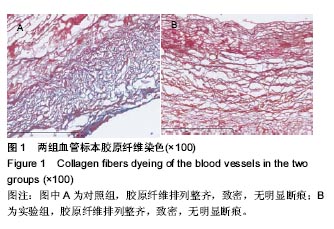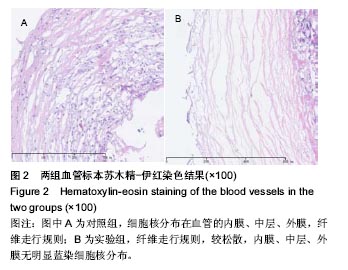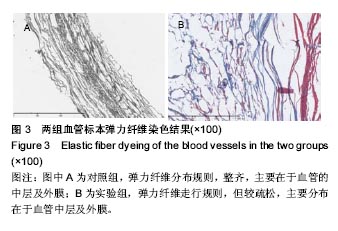| [1]Sukovatykh BS,Belikov LN,Sukovatykh MB,et al.Results of using various methods of autovenous femoropopliteal bypass grafting below the knee-joint fissure.Angiol Sosud Khir. 2016; 22(4):137-143.[2]Ramanathan G,Singaravelu S,Muthukumar T,et al.Design and characterization of 3D hybrid collagen matrixes as a dermal substitute in skin tissue engineering.Mater Sci Eng C Mater Biol Appl. 2017;3(1);72:359-370.[3]Frueh FS,Menger MD,Lindenblatt N,et al.Current and emerging vascularization strategies in skin tissue engineering.Crit Rev Biotechnol.2017;37(5):613-625.[4]Busra MF,Chowdhury SR,bin Ismail F,et al. Tissue-Engineered skin substitute enhances wound healing after radiation therapy.Adv Skin Wound Care. 2016;29(3):120-129.[5]Waller CJ,Cogbill TH,Kallies KJ,et al.Contemporary management of subclavian and axillary artery injuries - A Western Trauma Association Multicenter Review.J Trauma Acute Care Surg.2017.doi: 10.1097/TA.0000000000001645.[Epub ahead of print][6]Valverde García S,Peña Cortés R,Torre Eiriz J et al.Disruption in "non-anastomotic section" of an axillofemoral bypass. A thorough critical review of the literature.[J] Ann Vasc Surg. 2017.7.13. pii: S0890-5096(17)30846-4. doi:10.1016/j.avsg.[7]Bakkali T,Zoulati M,Aghoutane N,Bounssir A,et al.False aneurysm of the carotid artery revealing Behçet disease.J Med Vasc.2017;42(3):185-188.[8]Heger T,Strauß S,Blessing E,et al.Short and long-term results after endovascular management of vascular complications during transfemoral aortic valve implantation.Acta Cardiol. 2017:1-9.[9]Li YH,Wang JS,Yao C,et al.Risk factors of rupture of internal carotid artery during surgical resection of carotid body tumor.Zhonghua Yi Xue Za Zhi.2017;97(22):1724-1728.[10]Hwang PT,Lim DJ,Fee T,et al.A bio-inspired hybrid nanosack for graft vascularization at the omentum.Acta Biomater. 2016;41:224-234.[11]Hulin-Curtis S,Williams H,Wadey KS,et al.Targeting Wnt/β-Catenin Activated Cells with Dominant-Negative N-cadherin to Reduce Neointima Formation.Mol Ther Methods Clin Dev.2017;5:191-199.[12]Yasuda N,Goto K,Ohchi Y,et al.The efficacy and safety of antithrombin and recombinant human thrombomodulin combination therapy in patients with severe sepsis and disseminated intravascular coagulation.J Crit Care. 2016;36: 29-34. [13]Renal Autotransplantation with Autologous Saphenous Vein Graft in a Patient with Takayasu Arteritis and Existing Renal Artery Stent in Her Solitary Kidney.Urol Int.2017.doi: 10.1159/000475509.[Epub ahead of print].[14]He Y,Xu X,Zhu T,et al.Resident Arterial Cells and Circulating Bone Marrow-Derived Cells both Contribute to IntimalHyperplasia in a Rat Allograft Carotid Transplantation Model.Cell Physiol Biochem.2017;42(4):1303-1312.[15]Good BC,Weiss WJ,Deutsch S,et al.Asynchronous Pumping of a Pulsatile Ventricular Assist Device in a Pediatric Anastomosis Model.World J Pediatr Congenit Heart Surg. 2017;8(4):511-519.[16]Tepe G,Gögebakan Ö,Redlich U,et al.Angiographic and Clinical Outcomes After Treatment of Femoro-Popliteal Lesions with a Novel Paclitaxel-Matrix-Coated Balloon Catheter.Cardiovasc Intervent Radiol.2017.10.1007/ s00270-017-1713-2.[Epub ahead of print][17]Baek SE,Jang MA,Lee SJ,et al.5-Lipoxygenase in monocytes emerges as a therapeutic target for intimal hyperplasia in a murine wire-injured femoral artery.Biochim Biophys Acta. 2017;1863(9):2210-2221.[18]Guo H,Zhang W,Wang Y,et al.A good water soluble Lillie-Mayer hematoxylin and eosin Y staining solution.Diag Path J.2015;22(10):223-226.[19]Song W,Wang J.The study on improved old tissue sections HE staining method by using GS staining.Diag Path J. 2015; 11:1167-1172.[20]Zhang YD,Zhao SC,Zhu ZS,et al.Cx43- and Smad-Mediated TGF/ BMP Signaling Pathway Promotes Cartilage Differentiation of Bone Marrow Mesenchymal Stem Cells and Inhibits Osteoblast Differentiation.Cell Physiol Biochem. 2017; 42(4):1277-1293.[21]Li Y,Zhang J,Xu Y,et al.Effects of 630 nm Red and 460 nm Blue Light Emitting Diode Irradiation on Healing of the Skin Wound in Japanese Big-ear White Rabbit.Chin Med Sci J. 2017;39(3):301-306.[22]Tingting D,Na L,Bin G,et al.Effects of Aging on the Proliferation and Differentiation Capacity of Human Periodontal Ligament Stem Cells.Chin Med Sci J. 2017;32(2): 83-91.[23]Chong RS,Lee YS,Chu SWL,et al.Inhibition of Monocyte Chemoattractant Protein 1 Prevents Conjunctival Fibrosis in an Experimental Model of Glaucoma Filtration Surgery.Invest Ophthalmol Vis Sci.2017;58(9):3432-3439. [24]Tang Z,Niu J,Huang H ,et al.Potential biodegradable Zn-Cu binary alloys developed for cardiovascular implant applications.J Mech Behav Biomed Mater.2017;72:182-191. [25]Davis LA,Stewart SE,Carsten CG 3rd,et al.Characterization of fracture behavior of human atherosclerotic fibrous caps using a miniature single edge notched tensile test.Acta Biomater. 2016;43:101.[26]Stephen S,Agnihotri M,Kaur S.A Randomized, Controlled Trial to Assess the Effect of Topical Insulin Versus Normal Saline in Pressure Ulcer Healing.Ostomy Wound Manage. 2016;62(6): 16-23.[27]Roth SP,Erbe I,Burk J.Decellularization of Large Tendon Specimens: Combination of Manually Performed Freeze-Thaw Cycles and Detergent Treatment.Methods Mol Biol.2017.doi: 10.1007/7651_2017_49. [Epub ahead of print][28]McFerrin MB,Chi X,Cutter G,et al.Dysregulation of 14-3-3 proteins in neurodegenerative diseases with Lewy body or Alzheimer pathology.Ann Clin Transl Neurol. 2017;4(7): 466-477.[29]Wang W,Shao A,Feng S,et al.Physicochemical characterization and gastrointestinal adhesion of S-layer proteins-coating liposomes.Int J Pharm. 2017;529(1-2): 227-237.[30]Wang H,Fan S,Li L,et al.Preparation of human umbilical vein acellular matrix.China Tissue Engineering research and clinical rehabilitation.2007;11:335-337.[31]Xie H,Campbell CE,Shaffer BS,et a1.Different outcomes in urethral reconstruction using elastin and collagen patches and conduits in rabbits.J Biomed Mater Res B Appl Biomater. 2007;11(8):116-120.[32]Im SH,Kim CY,Jung Y,et al.Biodegradable vascular stents with high tensile and compressive strength: a novel strategy for applying monofilaments via solid-state drawing and shaped-annealing processes.Biomater Sci. 2017;5(3): 422-431.[33]Masselter T,Haushahn T,Fink S,et al.Biomechanics of selected arborescent and shrubby monocotyledons.Beilstein J Nanotechnol.2016;7:1602-1619.[34]Chaves C,Gao C,Hunckler J,et al.Dual-acting biofunctionalised scaffolds for applications in regenerative medicine.J Mater Sci Mater Med.2017;28(2):32.[35]Khurshid S,Afzal M,Khalid R,et al.Potential of multi-component antigens for tuberculosis diagnosis. Biologicals.2017;48:109-113.[36]Feavers IM,Maiden MCJ.Recent Progress in the Prevention of Serogroup B Meningococcal Disease.Clin Vaccine Immunol.2017;24(5):pii: e00566-16.doi: 10.1128/CVI.00566-16.[37]Easterhoff D,Moody MA,Fera D,et al.Boosting of HIV envelope CD4 binding site antibodies with long variable heavy third complementarity determining region in the randomized double blind RV305 HIV-1 vaccine trial.PLoS Pathog.2017;13(2):e1006182.[38]Donald RG,Hawkins JC,Hao L,et al.Meningococcal serogroup B vaccines: Estimating breadth of coverage.Hum Vaccin Immunother.2017;13(2):255-265.[39]Qin W,Wang L,Zhai R,et al.Apa2H1, the first head domain of Apa2 trimeric autotransporter adhesin, activates mouse bone marrow-derived dendritic cells and immunization with Apa2H1 protects against Actinobacillus pleuropneumoniae infection. Mol Immunol.2017;81:108-117.[40]Navarrete-Perea J,Moguel B,Bobes RJ,et al.Protein profiles of Taenia solium cysts obtained from skeletal muscles and the central nervous system of pigs: Search for tissue-specific proteins.Exp Parasitol.2017;172:23-29.[41]Veljkovic V,Veljkovic N,Paessler S,et al.Predicted Enhanced Human Propensity of Current Avian-Like H1N1 Swine Influenza Virus from China.PLoS One.2016;11(11):e0165451.[42]Hayward CJ,Fradette J,Morissette Martin P,et al.Using human umbilical cord cells for tissue engineering: A comparison with skin cells.Differentiation 2014;87(3-4):172-181.[43]Bao RM,Yang HM,Yu CM,et al.An efficient protocol to enhance the extracellular production of recombinant protein from Escherichia coli by the synergistic effects of sucrose, glycine, and Triton X-100.Prot Expr Puri.2016;126(10):9-15. |
.jpg)




.jpg)